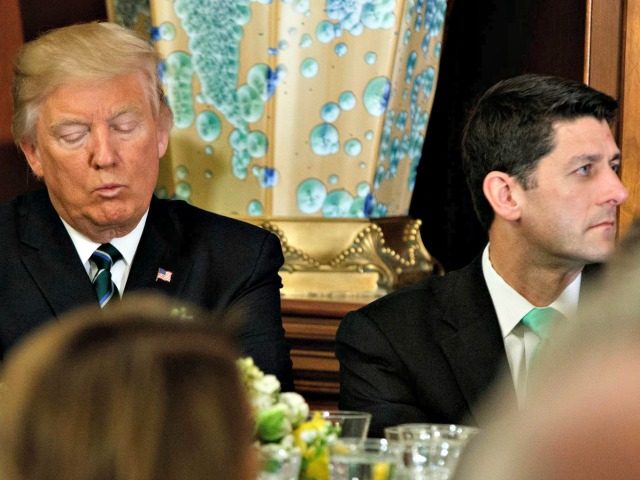Politico reported Thursday that President Donald Trump, chastened by his experience pushing for the failed Ryancare bill, is moving forward on tax reform with is own economic team in the lead–not Speaker Paul Ryan (R-WI):
Just on Thursday, President Donald Trump huddled with Treasury Secretary Steven Mnuchin, National Economic Council Director Gary Cohn, senior strategist Steve Bannon, son-in-law and consigliere Jared Kushner and staffers from the National Economic Council and Treasury to delve into the various policy trade-offs and ways to structure a plan.
The key takeaway: The White House is not outsourcing these details to anyone, including the speaker of the House.
The report said White House press secretary Sean Spicer confirmed this new dynamic at Friday’s news briefing: “The president will put out principles, I’m sure, in terms of what his goals are and drive this as the process moves forward.”
A 14-page paper, obtained by Politico and developed during the presidential transition, is the central blueprint for the president’s tax reform program–and it would push Ryan’s own Border Adjustment Tax off the table.
The president is expected to propose cutting the corporate tax rate to 15 percent combined with a wiping out of the tax code’s catalog of tax loopholes and deductions Congress created to ameliorate the 35 percent rate for business profits. Another part of the plan is to simply the individual tax rates, again by lowering the rates and removing specialized deductions.
Trump’s corporate and individual tax reforms are significant, but no way near the revolutionary changes contained in Ryan’s Border Adjustment Tax, which shifts $1 trillion in annual tax burden onto exported goods and exporters. That fight has already been going on behind the scenes, as domestic manufacturers and retailers line up allies and resources as they contest for who will be on the hook for one-third of the federal government’s annual revenues.
Ryan read Capitol Hill Republicans into his 200-day schedule that would carry on through Labor Day at the GOP lawmakers’ policy retreat held in Philadelphia in the last week of January. The schedule called for the House to focus on overturning President Barack Obama’s last-minute regulations through the Congressional Review Act, while the Senate focused on confirming the first wave of Trump administration appointees.
March was dedicated to the repeal-and-replace of the 2010 Patient Protection and Affordable Care Act, or Obamacare.
In April, the Senate would confirm the president’s choice to fill the Supreme Court seat made vacant by the death of Justice Antonin Scalia, and the House would tackle reforming the tax code—a process coupled with the approval of the fiscal year 2018 budget that would consume both chambers.
In Philadelphia, Ryan had not yet revealed that he would hijack the repeal-and-replace of Obamacare with his own bill that fell short of what Republicans had expected and had promised voters in every political cycle since Obamacare became law in 2010. The Ryancare bill alienated conservatives and frightened moderate Republicans hesitant to cast a politically risky vote for a bill that might not pass the Senate.
In the end, the speaker pulled the Ryancare bill from the House floor March 24, nearly 15 minutes from the roll call that would have meant its certain defeat.
If Ryan had a working majority in the House, he would be the man driving the agenda, he but does not have that majority, so the White House is moving forward with its own agenda and its own ideas.
The aborted American Health Care Act has been portrayed as a defeat for the president, who rallied for the bill in campaign-style events outside of Washington and behind closed doors at the White House and on Capitol Hill.
Now that things have settled, it appears that instead of a setback for the president, the failure of the speaker’s health care legislation was really Trump’s liberation.
During the 2016 presidential cycle, Ryan created “The Better Way” agenda as a parallel campaign platform, so that he and his allies could campaign for themselves without mentioning the president’s name nor offer him support.
Now, Trump has found his own better way.

COMMENTS
Please let us know if you're having issues with commenting.